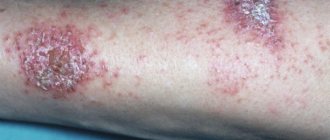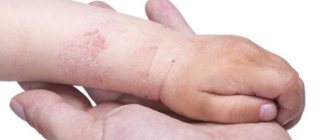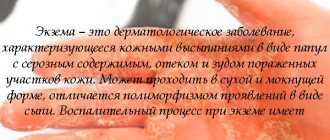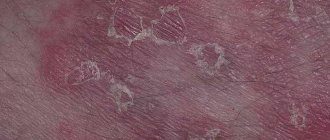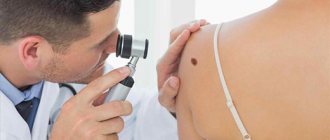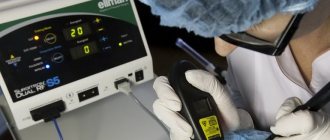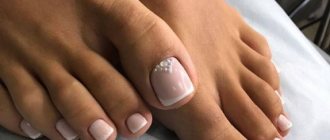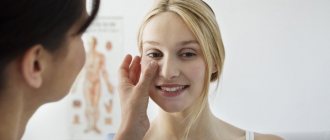Symptoms
The main signs of nummular eczema include:
- Formations on the skin in the form of pink-red, red or bluish plaques (vesicles) with an average diameter of 3-5 cm. The spots that appear slightly protrude above the surface of the skin and have a clear red edge, as can be seen in the photo below.
- Burning and itching in areas where vesicles later appear.
- Rash and peeling on the surface of bright coin-shaped spots, which forces patients to scratch the affected areas.
- Formation of erosions, weeping and fatty yellow crusts at the site of plaques.
- Discharge of pus on the affected areas (with secondary infection).
As inflammation decreases, the skin at the sites of formations dries out, and cracks often form on it. With frequent repetition of the “exacerbation-remission” cycle, coin-shaped pathology can develop into true eczema.
Most often, eczematous rashes are located on the legs, torso, legs and arms (particularly on the back of the hands). Plaques can be present on the patient’s skin for a long time (from 1 month or more), appear and disappear in the same areas.
Features of the course
This form of eczema is one of the most difficult types to treat.
In terms of its symptoms, the disease is extremely similar to fungal infections of the skin and psoriasis. To make a final diagnosis, a patch test must be performed on the patient. This will help exclude or confirm the torpid course of eczema. Eczematous coin-shaped (round) plaques can persist for months and sometimes years. Most often, vesicles form on the legs, torso, upper limbs and dorsum of the hands.
Source: allergycentr.ru
What is coin eczema
Monetoid, or nummular, eczema is a type of chronic skin pathology, as a result of which persistent dermatitis develops. It is no coincidence that this disease acquired its name. The cutaneous manifestation is coin-shaped. It has a bright burgundy color and slightly rises above the healthy area of the epithelium. This disease is widespread among people with weakened immune systems. Most sources refer to the microbial etiology of such a pathological process.
Coin-shaped eczema occurs among both male and female populations. The peak of exacerbations occurs during epidemics of colds.
Types of disease and main provoking factors
The disease affects any part of the human body, but most often occurs on:
- legs;
- hands (phalanxes of fingers);
- face;
- calves;
- buttocks.
The causes of the pathology are as follows:
- the presence of chronic foci of infection: tonsillitis, caries;
- tuberculosis infection;
- increased sweating;
- a lot of stress;
- drug abuse;
- vegetative-vascular dystonia;
- chronic venous insufficiency;
- violation of metabolic processes;
- chronic gastrointestinal diseases;
- hormonal disorders.
When the body is weakened due to the reasons listed above, the skin becomes susceptible to pathogens, while a healthy epidermis is able to form a protective barrier against microorganisms.
Factors for development
The exact causes of the development of nummular eczema in children and adults are unknown. It is widely believed that the formation of the disease is influenced by dry skin, but atopy (the body's predisposition to allergies) is not. Other possible causes of coin-shaped eczema are also mentioned:
- skin diseases - hyperhidrosis (excessive sweating), erysipelas, exsiccation (dehydration, drying out);
- allergy;
- synthetic additives, preservatives in cosmetics;
- disruption of the nervous and endocrine systems;
- harmful substances in the body;
- diabetes;
- chronic diseases - prostatitis, tonsillitis, bronchitis and other diseases;
- circulatory disorders.
Also, in 20% of examined patients, Staphylococcus aureus is detected on the skin, which can cause hypersensitivity to various bacteria. It is possible that the causes of the disease are hidden in a weakened immune system.
Unfortunately, such eczema still has an unclear etiology. The causes that provoke the occurrence of symptoms of the disease can be so-called topical allergens, in particular, the following:
- flavorings;
- certain medications (hydrocortisone, neosporin, bacitracin).
Coin-shaped eczema can also be triggered by the following factors:
- dysseborrhea;
- nervous system dysfunction;
- hyperhidrosis;
- metabolic disorder;
- hormonal disorders;
- exsiccation (the skin dries out and becomes rough);
- stressful situations;
The most adequate version of why chronic coin-shaped eczema occurs is dysfunction of the epidermis, which makes it vulnerable to negative external factors that significantly reduce the barrier function of the skin.
The clinical picture of a disease such as nummular eczema has its own distinctive features: the vesicles are clearly defined, have a pronounced round shape, and during an exacerbation the rash is very itchy. An outbreak of the disease can also be triggered by a secondary infection, which develops due to microbes entering the plaques.
Coin-shaped eczema most often begins on the inner surface of the thighs; gradually, lesions appear on the back of the hand and spread to the legs and torso. In the acute stage, the nummular form of eczema manifests itself as round plaques covered with yellowish or brown crusts.
Over time, such neoplasms crack and pus and ichor flow out of them - this indicates that eczema has affected the deep layers of the epidermis and destroyed small capillaries.
Source: odermatite.com
How to get rid of allergic eczema using folk remedies
To treat allergic eczema, cranberry juice lotions are used. Rubbing the skin with Kalanchoe juice shows good results. During an exacerbation, a lotion with crushed strawberries will help.
To eliminate itching and inflammation, you can mix vinegar and vegetable oil (1:1). The resulting composition is used to wipe the inflamed dermis. If the disease is accompanied by the formation of bubbles with a clear liquid, you can use a mixture of potato, cabbage, carrot and garlic juice. It is used for disinfecting compresses.
Treatment with folk remedies does not guarantee a complete cure for eczema. In addition, the use of alternative therapy must be agreed with the attending physician. Otherwise, side symptoms may develop, which significantly complicate the recovery process.
Traditional recipes are an addition to basic therapy, which can only be selected by a qualified doctor.
Skin care for eczema and atopic dermatitis
The mainstay of long-term treatment for all forms of eczema is maintaining the skin barrier using emollients and moisturizers while bathing, in both mild and severe cases. Regular use of emollients can significantly reduce the amount of topical steroid use in sicker patients. Ideally, emollients should be applied three to five times daily.
How to properly take a bath for eczema:
daily; without using washcloths and scrubs; do not take hot baths, as hot water further dries out the skin; add water-soluble oils to the bath. You can choose ready-made products for people with dry and atopic skin. The composition of such products must include soybean, almond oils, jojoba and wheat germ. There should be no sulfates in the composition; After taking a bath, be sure to apply a moisturizing and restorative emollient
This is very important: if you don't moisturize your skin immediately after showering, the moisture will evaporate and your skin will become even drier.
What types of moisturizers are most effective for eczema?
There are many regular moisturizers that don't work very well to control eczema or may even make it worse
It's important to understand the differences between the three main types of moisturizers: ointments, creams, and lotions to properly moisturize your skin and keep your symptoms under control.
Moisturizers are classified according to the amount of oil and water they contain. The more oil in a moisturizer, the better it will restore and moisturize skin with eczema. These products include emollients, which are something between an ointment and a cream.
All moisturizers should be applied to hands immediately after washing and gently patted dry. It's best to keep your moisturizer next to your sink and carry a small tube in your bag so you can use it at any time of the day.
Ointments are the first choice for the treatment of chronic and congestive eczema for patients over two years of age. They have the highest oil content, followed by creams and only then lotions. Vaseline and glycerin containing oils will create a protective film on the surface, but you should not overdo it with them so that there is no reverse greenhouse effect. If after applying the ointment you feel discomfort on the skin, then this is not your remedy; it is better to try an alternative - cream.
Creams seal moisture into the skin very well. Because they contain less oil, they are less greasy. Be sure to read labels carefully: creams sometimes contain stabilizers or preservatives that can irritate the skin. A cream necessary for skin with eczema and atopic dermatitis must necessarily include ceramides, ceramides, azulene, wheat germ oil, hyaluronic acid, 0.5% urea.
Lotions contain the least amount of oils. Since they are mostly water, they evaporate quickly and will need to be applied frequently. Such products are preferable to use in hot climates.
The choice of the form of care product largely depends on the location of the eczema. When the face is affected, given the high sensitivity of the skin of this area to steroids, preference is given to Crelo emulsion and cream. In case of damage to the scalp or other areas of the skin with abundant hair, it is recommended to use a solution, lotion, crelo, or cream. If eczema appears on the torso or limbs, choose crelo, cream, lipocrem, ointment, depending not only on the nature of the dermatosis, but also on climatic conditions.
Briefly about eczema once again
- Eczema appears mainly in the face and limbs.
- As eczema develops, the skin's ability to act as a barrier is reduced. The skin easily loses water and becomes dry.
- People with eczema and atopic dermatitis can and should be vaccinated.
- Itching is the main symptom of all types of eczema.
- Complex therapy is required: care + daily application of moisturizers + proper hygiene.
- Use a combination of topical medications at different stages of the eczematous process and only as prescribed by a doctor.
- Psychotherapy is an important aspect in the treatment of all patients with atopic dermatitis and eczema.
- Eczema is not contagious.
Prevention
In order to prevent the development of coin-shaped eczema, dermatologists recommend following simple rules:
- Carry out complete therapy for infectious and fungal diseases, preventing the occurrence of foci of inflammation.
- Use personal protective equipment when in contact with household and industrial chemicals.
- Regularly stay in the fresh air and ventilate the house.
- Avoid stress, overwork and lack of sleep.
- Maintain a hydration regime (1.5-2 liters of water per day) and consume enough microelements.
- Adhere to proper nutrition: introduce bran, fish, cereals, vegetable soups and low-fat sources of protein into your diet.
Among other things, you need to reduce your consumption of possible allergens. During treatment, the patient requires a strict elimination diet.
Why does coin-shaped eczema occur on the skin?
Unfortunately, the obvious causes that can cause coin-shaped eczema are not known to modern medicine. Some scientists consider epidermal dysfunction to be a possible variant of the disease. The disease can manifest itself in both adults and children. This disease affects people regardless of social status, gender and level of life.
Recently, some factors have been identified that most often lead to coin-shaped eczema:
- decreased protective functions of the skin;
- circulatory disorders;
- metabolic disease;
- disruption of the nervous system;
- intoxication of the body;
- diabetes;
- chronic diseases.
This type of eczema is best treated comprehensively. Along with the dermatologist's prescriptions, you can also use well-known traditional medicine. They will help relieve itching, inflammation, swelling and speed up the healing of eczematous lesions.
Folk remedies for treating coin-shaped eczema
1. Coin eczema can be treated with fresh potato juice. It will soften the skin and relieve flaking. To do this, soak a cotton napkin in the juice and apply it to the affected skin for 15 minutes at least three times a day.
2. A good therapeutic effect is achieved with this home treatment. Take white cabbage and grind it in a blender. Egg white is added to the mass, stirred thoroughly, spread on gauze and applied to eczematous plaques. Such procedures are recommended to be carried out twice or thrice a day.
3. A compress of sea buckthorn oil should be applied to peeling lesions. The bandage should be soaked in sea buckthorn and applied to the affected areas of the skin. Peeling will decrease, the skin will become moisturized, and the itching will stop.
4. A decoction of walnut leaves and bark heals the skin well. You will need 400 grams of raw material, fill it with water, bring to a boil, and then leave for 2 hours. The finished broth is poured into a hot bath. Take the therapeutic water procedure for at least 20 minutes.
5. In the acute stage of coin-shaped eczema with suppuration and bleeding, it is necessary to take a bath with a bactericidal decoction of herbs. You will need: pine branches with needles, cones, yarrow, chamomile and geranium. For five liters of water take 200 g of plant material. The broth is boiled for 15 minutes and the strained mixture is poured into the bath.
6. Young elderberry leaves have antiseptic properties. They are doused with boiling water and applied to the lesions with plaques.
Inflammation, peeling and itching will go away if you use this folk recipe. You need to collect fresh leaves of the plant, pass them through a meat grinder and pour a little milk into the resulting mass. At night, apply a healing mixture to the plaques, cover the top with parchment paper or cellophane film and tie with a bandage. The course of treatment is at least two weeks.
7. This recipe gives very good results in treating eczema. Take grapes (unripe ones are also possible) and squeeze out the juice. Moisten gauze and apply to the affected skin for one hour. The procedures are carried out twice a day for three weeks. The course of treatment can be repeated.
8. For weeping plaques and suppuration, coin-shaped eczema is treated with Kalanchoe. Squeeze the juice from two leaves, soak a bandage in it and apply it to the inflamed areas for 10 minutes.
9. In the remission stage, healers recommend treating coin-shaped eczema with tar. Prepare the following mixture: tar, fish oil, apple cider vinegar. At the same time, the ratio of components is maintained: 1:3:1. The finished ointment is laid out on a thin cotton napkin and applied to the skin affected by eczema.
10. Such a remedy for treating the disease is also known. Boil a peeled head of garlic, mash it until mushy and add honey. The resulting mass is spread on a sterile bandage and applied to the body. The top is covered with paper (for compresses) and secured with a bandage. Keep the product on the body all night, then remove it, lubricate all affected areas with gasoline and apply the same bandage with garlic again. When the skin improves its condition a little, such compresses can be done only once a day - at night.
11. Skin with eczema will clear and gradually heal if you take corn oil orally daily. Add a teaspoon of vinegar and a little honey to a glass of water and stir. In the morning on an empty stomach, drink a tablespoon of unrefined oil and wash it down with water with the indicated ingredients. The skin will soon become softer and stop peeling.
When using folk remedies to treat coin-shaped eczema, do not forget to first consult with your doctor.
Varieties, symptoms
The disease can be characterized by several or all symptoms at once - it depends on the type of disease and severity. The main characteristics of the bacterial species are:
- rashes;
- red spots of various shapes;
- itching;
- burning;
- the presence of small bubbles with liquid (with weeping eczema);
- scales and ulcers in more advanced forms.
Nummular (coin-shaped or plaque-shaped)
Nummular eczema is a subtype of bacterial eczema. It is characterized by the presence of single or generalized round-shaped inflammations. Feature – difficult to treat.
The characteristic features of the coin-shaped form are:
- round shape with a diameter of 1-3 cm;
- the affected areas are often pink or red, less often bluish;
- constant itching;
- formation of crusts and cracks in neglected forms;
- elevated temperature;
- weakness.
Varicose veins in chronic venous insufficiency
The presented appearance occurs against the background of impaired blood microcirculation and response to treatment. Initially, inflammation may occur, which then develops into ulcers. This subspecies is the easiest to cure. Not only traditional methods of treatment are used here, but also surgical intervention.
Venous eczema spreads to the lower extremities, where varicose veins appear. The lesions have an asymmetrical shape with clear boundaries. Along the periphery, peeling of the upper layers of the cover in the form of hills is observed.
Symptoms of the venous form:
- red skin on affected areas;
- increased skin temperature of the affected areas, feeling of heat;
- presence of swelling;
- itching with burning;
- vesicles, sometimes opened.
Post-traumatic
Post-traumatic eczema develops after injury to the skin, scars, or amputation of a body part. This type is characterized not only by external manifestations, but also by internal ones. Disturbances in the patient's nervous system are common.
This disease is not always the result of wounds or amputation. Some may have a genetic predisposition to post-traumatic eczema. In addition to the standard itching and redness of the skin, with this type of disease the presence of:
- swelling;
- rash in the form of blisters;
- full of pus;
- crust.
Sycosiform
A common location for this subspecies is the face, most often in the area of hair growth above the upper lip, chin and cheeks. They also appear in the groin area and armpits. Where there are hair follicles.
Staphylococci that infect the follicle lead to the formation of an inflammatory process and the presence of purulent fluid. Sycozyform eczema appears as small lesions similar to pimples. Sometimes they go beyond the boundaries of the hairline.
This species is characterized by all the main listed characteristics. Scratching and intense itching can cause the affected area to become wet, causing crusting to form.
Nipple eczema
Bacterial nipple eczema occurs in women due to injury during breastfeeding. Mothers prone to allergic reactions are at risk. The disease manifests itself in the first weeks of lactation.
The first signs are itching of the nipples and areolas. Then they become red and small pimples appear, which are accompanied by wetting. Lesions may have clear boundaries covered with scales. Pain occurs during feeding. There is also itching, which intensifies at night.
Diagnostics
Diagnosis of coin-shaped eczema is not difficult.
The diagnosis is made by a dermatologist based on the clinical picture and medical history. Taking into account the concomitant pathology, a standard laboratory examination is required: OBC, OAM, biochemistry. Patients are consulted by a gastroenterologist, neurologist, allergist, and endocrinologist. Histopathology is atypical, morphological examination is carried out only for differential diagnosis. Complicated forms require enzyme immunoassay and allergological testing of blood serum for antibodies (specific IgE/IgG, general IgE) .
If an infection is suspected, microbiological studies of epidermal smears are prescribed. In case of secondary infection, a cultural study is carried out to identify the pathogen and determine its sensitivity to antibiotics. Coin-shaped eczema is differentiated from dermatitis, psoriasis, scabies and dermatomycosis.
The flap test often gives an important positive result in 1/4-1/3 of cases. Culture may reveal Staphylococcus aureus. Antibacterial treatment usually helps, but often does not lead to remission. Differential diagnosis is carried out with the following diseases:
- Psoriasis (often more symmetrical and has a “geographical” pattern of lesions with silvery scales).
- Fungal infections (the lesions regress in the center and peel off at the periphery; potassium hydroxide testing helps in making a differential diagnosis).
- Cutaneous T-cell lymphoma of the lower extremities (this can be mistaken for coin-shaped eczema; a biopsy helps rule out the diagnosis).
Coin eczema can be similar to a fungal infection or psoriasis. The boundaries of lesions in fungal infections and psoriasis are usually more clearly defined. The most typical sites of involvement are the dorsum of the hands, legs, upper limbs and torso.
Differential diagnosis
Psoriasis (often more symmetrical and “geographical” lesions with silvery scales). Fungal infections (the lesions regress in the center and peel off at the periphery; testing with CON helps in making a differential diagnosis). Cutaneous T-cell lymphoma on the lower extremities (this can be mistaken for coin-shaped eczema; a biopsy will help exclude the diagnosis).
Source: allergoportal.ru
Causes of the disease
The exact causes of the occurrence and development of eczema have not been identified. Most dermatologists agree with the statement that the disease is caused by chronic inflammatory processes in the body (tonsillitis, tuberculosis and even untreated caries). With this form, the humoral and cellular components of immunity are disrupted, which is revealed in the characteristic reaction of the skin (coin-shaped lesions) to the entry of an antigen into the body. This condition indicates a violation of the protective functions of the epidermis.
Coin eczema is a type of microbial eczema
Since coin-shaped eczema is a form of microbial eczema, the causes include pathogenic bacteria. The etiology of this disease is not yet completely clear to science. The skin with coin-shaped eczema is in a state of readiness to fight back against the antigen.
In many patients, the monovalent form turns into a polyvalent one, and the patient most often turns to the doctor with the second form, which significantly complicates the treatment process. That is, at the initial stages, the skin reacts only to one type of irritant, but over time to many.
If we consider genetics, the disease is classified as multifactorial with gene penetrance. So, if one of the parents is affected by eczema, then the chance of this pathology occurring in the child will be 40%, if both - 60%.
A huge role is played by violations of membrane barriers in the gastrointestinal tract, which allow foreign substances to enter the human body. As a result, an allergic reaction occurs at the level of the epidermis and dermis. Immune reactions turn into autoimmune reactions (the skin structure is destroyed). Then, the protective properties of the dermis are disrupted, which makes the skin vulnerable to various types of infections. Next begins the stage of exudation and erythema (redness). Polymorphic rashes form on the affected areas.
Possible reasons that provoke the appearance of such a rash include:
- Problems with the functioning of the endocrine system. As a result, there is a rapid development of allergic reactions.
- Diseases of internal organs (impaired functioning of the kidneys, liver, gastrointestinal tract). Gastrointestinal disorders lead to the fact that the skin must more actively remove harmful metabolites. The accumulation of these kinds of toxins can provoke coin-shaped eczema.
- Increased sweating (hyperhidrosis).
- Disturbances in the functioning of the nervous system.
- Entry of pathogenic microorganisms into the body.
- Epidermal dysfunction.
- Hormonal disorders.
- Frequent stressful situations.
- Diabetes.
- Metabolic disorders.
- Hereditary factor.
- Direct contact with the irritant.
There is no specific single cause. Most often, coin-shaped eczema develops due to a complex of endogenous and exogenous factors. The neuro-allergic nature of this disease cannot be ruled out.
Acute stage of the disease
The disease, which occurs in an acute form, is characterized by the release of ichor and pus from the lesions, due to which coin eczema takes on a weeping form, which indicates the destruction of capillaries and the disease affecting the deep layers of the skin. Sometimes, against the background of the main disease, a secondary infection develops, which occurs due to constant scratching of the affected skin areas, into which harmful microorganisms easily enter.
Advice! With coin-shaped eczema, special attention should be paid to the diet, the components of which should be the following foods: boiled meat, dairy products, vegetable dishes, fruits.
Classification
There are several types of eczema that have the most characteristic clinical picture against the background of symptoms common to this disease.
- Idiopathic eczema. In the acute period of the disease, the skin swells and small blisters appear on it, which quickly burst and expose ulcers called serous wells. The wound surface does not bleed, but the released clear liquid dries to form yellowish crusts. Under them, erosions heal, and the disease ends until the next relapse.
- Microbial eczema. Based on the name, it is associated with the attachment of bacterial flora in places of permanent damage to the skin and mucous membranes. In addition to the main symptoms inherent in idiopathic eczema, this form is characterized by layers of hardened pus. The process of the appearance of rash elements and their development is accompanied by itching and scratching. Nummular eczema is a variation of this form.
- Mycotic eczema. The disease occurs as a result of an allergic reaction to the introduction of fungal spores into the body. The body produces antibodies to foreign proteins and thereby tries to eliminate the fungus, but the places where micelles have formed also suffer from the aggressive effects of the immune system.
- Seborrheic eczema. It appears, logically, in patients already suffering from another dermatological pathology. Rashes appear on areas of the skin that have many sebaceous glands (for example, scalp, ears, nasolabial folds, etc.). The spots merge with each other and form something like garlands.
- Occupational eczema occurs in people who are constantly in contact with active chemicals.
- Tylotic (horny) eczema occurs exclusively on the palms and soles. Manifests itself in the form of calluses and diaper rash.
- Childhood eczema is associated with the child's allergic disposition due to family history (the presence of allergies in close relatives). It is one of the most common forms of this disease.
Possible complications
Almost any disease, including nummular eczema, can be complicated by an acquired infection, which subsequently gives rise to the formation of purulent inflammation. A possible complication of the disease can be determined by the following signs:
- My health is getting worse every day, my body temperature is rising.
- At the site of the eczematous rash, purulent blisters appear.
- After opening the purulent blisters, a weeping hole with an unpleasant odor is formed.
Of course, one of the serious complications that can occur with nummular eczema should be highlighted - erythroderma. This condition is caused by more intense inflammation in large areas of the skin.
Source: medoderm.ru
Symptoms
Clinical manifestations are presented in the form of pink round spots resembling nickels (diameter does not exceed 3 cm). The elements have clear outlines and rise above the skin. The spots appear against a background of excruciating itching. Mainly localized on the skin of the extremities.
Almost immediately, papules, nodules and serous bullae appear on the surface of the spot, which are the primary elements of the rash. Unbearable itching leads to severe scratching, as a result of which the spots become covered with hemorrhagic crusts.
At the same time, the vesicles open, revealing erosive surfaces, which leads to the addition of a secondary infection.
The remaining and new vesicles transform into pustules and also open, forming erosions covered with purulent crusts. Papules connect with each other, forming plaques, the boundaries of which consist of remnants of epithelial cells.
Spots may also appear on the trunk and buttocks.
In this case, the bullae are opened, revealing erosive surfaces from which serous fluid is released. Large elements combine with each other, fresh rashes do not appear, and the pathological process declines.
Over time, thick yellow crusts appear on drying erosions. If staphylococcus joins the process, then when you press on them, pus appears.
Plaques differ from papules in that they do not merge, but bacteria can seed them around the perimeter with pustules. In case of injury to such an element, the process begins to spread by “screenings” of allergens, which consist of erythema, bullae and nodules.
Secondary rashes turn into weeping erosions. As inflammation decreases, the skin dries out and cracks may occur.
In the case of frequent alternation of exacerbation of the process and its remission, coin-shaped eczema can transform into true eczema.
Treatment methods
Treatment methods for this disease are generally identical, regardless of age and gender. But at the same time, tactics can still change. For example, in children, the disease requires the use of certain medications, as well as constant monitoring. Therefore, it is worth understanding the treatment methods better.
In children
In pediatrics, coin-shaped eczema is not the most common diagnosis, but it does occur.
It is important to seek help in time
This is explained by the fact that this disease can quickly develop into erythroderma, which ends in the death of the patient. And the younger the child is, the higher the risks.
Doctors prefer to provide inpatient therapy, although they can prescribe home treatment. Mainly used:
- local and general hormonal drugs;
- antihistamines;
- wound-healing local preparations;
- immunomodulators;
- vitamin supplements.
Hormonal drugs require a clear regimen of use, as they can significantly affect the immune system and cause a number of negative effects. Therefore, it is not recommended to use medications on your child yourself.
In therapy, it is necessary to correctly correct the functioning of the immune system, simultaneously removing the main symptoms of the disease.
In children, coin-shaped eczema manifests itself in rashes of the same type as in adults, and can reach an area of 3 cm in specific foci.
After the symptoms are eliminated and the redness subsides, flaking and cracking areas appear at the site of inflammation. Therefore, for this condition, ointments like Bepanten, Panthenol and other similar analogues are used.
When an infection occurs, the use of antibiotics and antimycotics is required, depending on the specific pathogen. A doctor should select the composition, since using the wrong medication can lead to progression of the condition and the development of superinfection. The latter is difficult to treat and requires long and difficult treatment in the infectious diseases department.
Elderly people are distinguished, first of all, by a decrease in the activity of processes in the body. Therefore, the use of products should be carried out under the supervision of a dermatologist in order to track the dynamics of the pathology. The same drugs are used in the elderly as in children, but with different dosages.
In addition to drug treatment, active prevention of the disease is mandatory. This will reduce the intensity of symptoms and accelerate the onset of remission, that is, the subsidence of the disease. Physiotherapy will also be relevant in therapy for older people. The PUVA method is used, that is, phototherapy. It has an ultraviolet effect on the skin and helps dry and eliminate weeping lesions.
Elderly and weakened patients are more difficult to treat for coin-shaped eczema due to a decrease in the activity of internal processes.
In teenagers and adults
Since coin-shaped eczema is the most treatment-resistant type of dermatitis, treatment for adults will have its own characteristics.
First of all, you need to correct the somatic component of the pathology, for example, stress. You also need to examine the endocrine, nervous and digestive systems. Based on the data obtained, drug treatment is prescribed based on:
- sedatives;
- neuroleptics, antidepressants, tranquilizers;
- regenerating local products;
- antihistamines;
- topical steroids;
- antibiotics;
- plasma replacement agents;
- detoxification medications.
The last four are usually prescribed in advanced or complicated cases. To prevent a new exacerbation, a course of histaglobulin is often prescribed. Additionally, vitamin therapy, enzyme and sulfur-containing medications, and probiotics are introduced into the course.
Treatment tactics will largely depend on the symptoms. For example, if there is severe weeping, aerosol hormonal medications are the best.
Physiotherapeutic measures also show good results. These include ultraphonophoresis, PUVA therapy, photophoresis, ultraviolet irradiation, UHF, ozone, magnetic, oxygen therapy, mud therapy, paraffin therapy, acupuncture. Severe cases require introduction to a course of plasmapheresis and hemosorption.
Probability of relapse
Unfortunately, nummular eczema is a chronic disease. This means that it can be put into remission, but complete recovery is a rare occurrence in the practice of dermatologists. The lack of therapy creates conditions for chronicity of the condition and increased frequency of relapses. But even if there is a remission stage, without prevention and compliance with the doctor’s recommendations, exacerbations will occur more and more often. If the disease affects large areas of the skin, it is recommended to undergo inpatient therapy in the infectious diseases department.
Treatment with folk remedies for wet eczema
Weeping eczema occurs in a complex form. Her therapy requires an integrated approach. By combining medication with folk remedies, you will be able to achieve a positive result faster.
| Recipe | Composition, method of preparation and use |
| Sulfur ointment | Sulfur is sold in every pharmacy; it helps fight weeping eczema. For the ointment, you need to mix sulfur and butter in equal proportions and grind until smooth. The composition is rubbed into the affected areas 2-3 times a day. |
| Composition based on chicken eggs | In a clean container, mix a raw chicken egg and 1 tbsp. l. vinegar. Stir until smooth and creamy. Lubricate the affected areas with the composition, then insulate this part. |
| Compress from coltsfoot | Grind the leaves of the plant, add milk so that the composition is similar to cream. Apply the product to the skin, wrap everything in a plastic bag, and wrap it with a warm cloth on top. |
| Cumin decoction | Boil one spoon of the plant in a glass of water. Leave for about two hours, strain. Wipe the decoction onto damaged skin. |
| Young walnut leaves | Grind the leaves, pour boiling water and leave for 3 hours. Use as compresses on the affected dermis. |
| Cabbage leaf lotion | Boil cabbage in milk, add bran to the mixture, leave for one hour. Apply to eczema until symptoms relieve. |
Treatment
Coin-shaped eczema is one of the most treatment-resistant dermatitis. The goal of treatment is to achieve stable remission. First of all, it is necessary to sanitize foci of chronic infection, correct somatic pathology, and normalize the functioning of the nervous, endocrine and digestive systems.
Desensitizing drugs are prescribed. In complicated cases, topical steroids (according to individual regimens in short courses), antibacterial drugs, detoxification and plasma replacement agents are indicated. To prevent exacerbation, a course of histaglobulin is prescribed.
Additionally, it is possible to use vitamin therapy, purified sulfur preparations and enzymes that improve the functioning of the digestive tract. To prevent dysbiosis, bifido-containing and lactose-containing products are indicated.
External treatment tactics depend on the severity of the process. In case of severe weeping, hormonal aerosols, wet-dry dressings, anti-inflammatory lotions, antibacterial and astringent preparations based on zinc give good results.
When the process subsides, ointments with topical steroids, antibacterial and antiseptic agents are used. Topical steroids are also effective for itching. Pyodermic layers are treated with antibacterial therapy internally and externally, depending on the extent of the skin lesion.
A good effect is achieved by ultraviolet irradiation, PUVA therapy, photophoresis, ultraphonophoresis, UHF therapy, magnetic, ozone, oxygen therapy, acupuncture, therapeutic mud, paraffin applications. In severe cases, hemosorption and plasmapheresis are used.
Stop all non-essential topical moisturizers, oral over-the-counter medications, dietary supplements, and herbal medications for at least 3 to 4 months.
A study should be conducted for the presence of mycosis of the feet, a fungal infection; if present, it is treated with antifungal drugs, since sometimes generalized coin-shaped eczema can be an “icb reaction to a distant localization of a fungal infection.
During pregnancy
During pregnancy, a woman may develop coin-shaped eczema due to extreme stress or a special diet. Initially, the disease manifests itself in the form of slight redness of the skin, after which cracks form on the patient’s body, accompanied by unpleasant sensations (severe itching).
Sometimes a hereditary factor plays a decisive role. In rare cases, the itching can be so severe that a woman is forced to scratch her skin.
This opens up access for infection to the patient’s body. To treat this pathology, caffeine, calcium chloride or sodium bromide are prescribed. The task of these funds is to stabilize the nervous system of a pregnant woman and resume metabolic processes in her body.
Treatment in children
The symptoms of the disease in children are slightly different from adults. The spots usually form on the surface of the skin of the shoulders and buttocks. The plaques do not merge into one large formation, as happens in adults. Treatment in children involves the use of corticosteroid medications that contain fluoride. These remedies can relieve itching, but they can also be addictive. This must be taken into account during long-term treatment.
The appearance of coin-shaped eczema in small children is possible starting from three months. At first, a small area of skin will be visible in the form of a reddened, rough spot that will peel off. The baby will begin to behave restlessly, every now and then trying to touch the spot, and may itch severely.
A wound will gradually form in this area of the skin, where bacteria can enter, which will lead to the appearance of a purulent infection. If the treatment procedure is not effective, ugly scars will remain on the baby’s body forever.
First, you need to reduce the amount of liquid your child consumes, as well as salts and carbohydrates, because they can increase the inflammatory process existing in the body. It is necessary to remove all irritating foods from the child’s diet: meat broths, canned food, hot spices, sweets, milk.
During this period, the following foods will be very useful: low-fat soups, boiled meat and fish, vegetables, dairy products. The course of treatment of coinoid and numular eczema with medications should be prescribed individually by a medical specialist, taking into account the age of the sick child and the characteristics of the pathology. Self-medication for these diseases is unacceptable.
How to treat?
The treatment procedure for nummular eczema is a very labor-intensive and lengthy process that requires a lot of effort. Constant care of the patient's skin and treatment with medications of different spectrum of action are necessary. In addition, it is impossible to do without general strengthening therapy, which can increase the body’s resistance to various diseases.
Medicines
There are a large number of medications that can effectively combat the symptoms of nummular eczema. You can easily find most of them on the shelves of city pharmacies. But not all of them can help in your particular case. Let's look at the most common drugs prescribed by dermatologists.
These include:
- sedatives (tincture of motherwort, Novopassit, etc.);
- means to improve blood circulation in the body;
- antiallergic drugs (Zitrek, Cetrin, Claritin and others);
- corticosteroid drugs (Prednisolone).
Many doctors prescribe the use of topical emollients to moisturize the skin and reduce inflammation. Such drugs can not only prevent loss of moisture from the skin, but also reduce the amount of hormones produced by the patient’s adrenal glands. This improves the patient's general condition and facilitates treatment.
If the disease is acute, doctors prescribe potent drugs in the form of creams and lotions. They are often water or oil based. If no drug copes with the disease, systemic steroids are used. In such cases, treatment with immunosuppressants is prescribed. Treatment should be under the supervision of a physician, since steroid hormones can lead to complications and side effects. Therefore, self-medication is strictly prohibited.
Folk remedies
In some cases, doctors prescribe the use of folk remedies as a complement to traditional methods of treating nummular eczema. They are also used by people who do not trust medications. And this is not strange, because folk remedies contain exclusively natural ingredients.
The most effective folk remedies:
- To treat the symptoms of nummular eczema, you can prepare a homemade ointment , which will include chicken eggs and table vinegar. To prepare the product, you need to mix one chicken egg and 50 grams of vinegar with clean water in a small vessel. All ingredients must be thoroughly mixed until smooth. Apply the prepared ointment to the affected areas of the skin. After application, the skin must be protected with cotton cloth. Socks, gloves or knee socks can be used for this purpose. The procedure should be performed in the evening, before going to bed. The duration of the therapeutic course is 7-10 days or until symptoms disappear completely;
- oak bark infusion prepared at home helps well in the treatment of nummular eczema One large spoon of crushed bark should be poured with 0.5 liters of boiling water and boiled in a water bath for 5 to 10 minutes. Then strain the liquid through several layers of gauze and add 1 tablespoon of honey. This product must be applied to the affected areas of the skin several times a day. Use the product until the symptoms of nummular eczema completely disappear. The duration of treatment is from 10 to 15 days (the duration of therapy may be influenced by the complexity of the disease or the genetic characteristics of the patient).
The treatment procedure for nummular eczema is quite complex, so you should consult a doctor before taking any medication. This also applies to folk remedies.
Features of treatment during pregnancy
During pregnancy, the presence of nummular eczema in the mother can lead to the risk that the baby will also suffer from the symptoms of this disease after birth. Therefore, it is necessary to treat the disease in a timely manner and not let it progress. To do this, doctors prescribe certain types of hormonal ointments and other products that are safe during pregnancy.
These products include Thymogen, a medical product produced in the form of a cream. In addition to traditional medicine, doctors strongly recommend following a diet that should include exclusively natural products, as well as walks in the fresh air. All this will improve the health of the mother, as a result of which the risk of infection of the fetus is reduced.
In children
The symptoms of the disease in children differ slightly from those in adults. Red spots usually appear on the surface of the skin of the buttocks and shoulders. The plaques may not merge into one large formation, as can be seen in most adults.
Treatment in children involves the use of corticosteroid medications, the main component of which is fluoride. These drugs can relieve the patient from unbearable itching, but with long-term treatment they can also become addictive. This fact must be taken into account when treating nummular eczema.
Therapeutic diet
In addition to the use of medications, doctors also prescribe diet therapy, the task of which is to cleanse the patient’s body and normalize its metabolic processes. Such diets have one thing in common - the refusal to eat all irritating foods.
A patient suffering from eczema should avoid:
- spices and hot seasonings;
- fish;
- walnuts;
- berries and citrus fruits;
- alcoholic drinks;
- seafood;
- dyes and preservatives;
- chicken eggs.
By following a diet, the patient can not only protect his body from nummular eczema, but also strengthen the immune system.
How to quickly cure eczema on the scalp in the hair? The most effective methods and means.
What remedies can you use to get rid of weeping eczema? Read in this article.
Read more about treating eczema on the face -
Application of physiotherapy
To speed up recovery, doctors often prescribe physical therapy. In the acute stage, procedures are used less frequently, but after the disappearance of severe symptoms or when they become chronic, they can achieve improvement. The most commonly used methods are:
- Paraffin therapy is a popular and effective technique used for many skin pathologies. Its essence is to apply warm paraffin applications to the stained areas. The session time is 15 minutes, it must be repeated up to 3 times a week, the number of procedures is from 10 to 15. Paraffin has a positive effect on the skin, stimulates regeneration, relieves itching and inflammation.
- Electrophoresis using Prednisolone or Hydrocortisone. During the session, the affected areas are exposed to a special low-frequency current, which is supplied to the skin through pads soaked in the solution. Thanks to electrical impulses, the drug particles quickly penetrate to the site of inflammation and have a pronounced therapeutic effect. 10 procedures are enough to obtain a lasting result.
- Sanatorium-resort treatment is indicated in cases where coin-shaped eczema is accompanied by severe nervous disorders. Staying the patient in a cozy and quiet place will reduce stress and improve general condition. In addition, in almost every sanatorium, patients undergo treatment with mud, mineral waters and other useful procedures.
